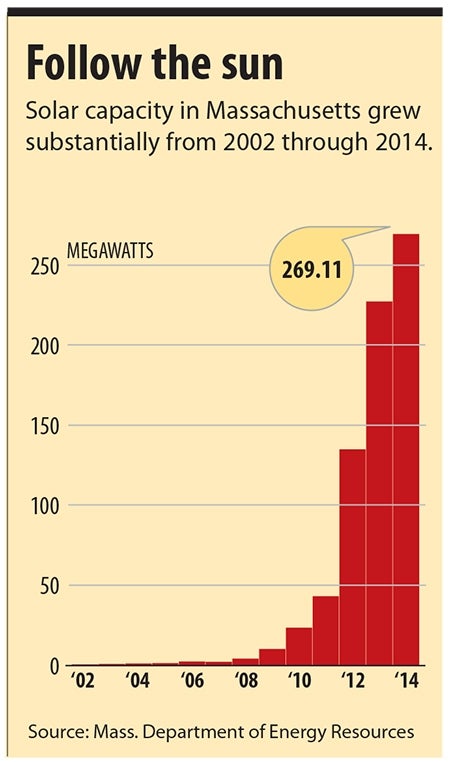As solar use goes up, costs are coming down
Massachusetts’ use of solar power has been on a tear. In 2007, developers, businesses and homeowners had installed less than 2 megawatts of photovoltaic capacity. But that doubled the next year, then the next, and the next.
In 2014, the state reached a record level of 269 MW of new installations, and as of last month, the total capacity of the state’s solar panels stood at 776 MW.
Gov. Charlie Baker has signed on to the Patrick administration’s goal of reaching 1,600 MW by 2020. But that target represents a major slowdown in installations over the next few years. To some environmentalists, it looks as if the state isn’t moving fast enough to make a real dent in its dependence on climate change-stoking fossil fuels. But utilities such as National Grid warn that aggressive attempts to promote solar could drive up their customers’ electric bills. Ben Hellerstein of Boston-based Environment Massachusetts said his group was pleased with Baker’s decision to recommit to the 1,600-megawatt goal, but it believes the state can go well beyond that.
“Over the last couple of years we’ve really seen solar power just expanding so rapidly in Massachusetts,” he said. “The costs have come down rapidly.”
Even with the recent growth in solar projects, this past December solar energy produced only slightly over 1 percent of the state’s electricity, according to the U.S. Energy Information Administration. Hellerstein said the current target would bring production to between 3.5 and 4 percent in 2020. But Environment Massachusetts has a much higher goal in mind: 20 percent by 2025. Hellerstein said he’s not sure exactly what it would cost to hit that, but he said the state could take big steps by continuing and expanding existing programs.
How solar is incentivized
Currently, Massachusetts incentivizes solar installations in two ways, both connected to the state’s power companies. First, the state offers solar renewable energy credits, or SRECs, to system owners. SRECs can be bought and sold by various parties, with prices fluctuating based on supply and demand. But their value ultimately comes from a requirement that utilities must own a certain number of the credits. Meanwhile, Massachusetts also requires net metering, which requires power companies to buy electricity from solar systems at the same rate at which they sell it. Because the utilities still have to maintain the grid that’s used to bring electricity from the solar panels, this ends up being another cost for them — and, ultimately, for the ratepayer.
To keep the cost of electricity down, Massachusetts officials have been examining both the SRECs and the net metering system. When he reaffirmed the 2020 solar power goal, Baker also said he wants to revisit incentives for solar, given that the cost of photovoltaic installations has fallen significantly in recent years. Meanwhile, National Grid, the utility that covers much of Central Massachusetts, hit a state-created cap for private solar installations in mid-March, reducing incentives for large solar projects in the area. (Small installations such as rooftop panels on homes are exempt.)
Environment Massachusetts has called for the state to raise the cap. But National Grid spokesman Jake Navarro said that’s a bad idea until the state develops a long-term plan to keep the costs of expanding solar under control.
“Raising the net metering cap will affect National Grid customers more than other utilities, further increasing rates at a time that our customers are looking to us to minimize higher electricity bills,” Navarro said in an email. “Instead, we need to introduce a more transparent process which could substantially lower the costs of solar and continue to nurture the industry.”
The state is requiring National Grid and other utilities to create grid modernization plans that can better support the transmission of electricity from renewable sources. Navarro said that should help expand the use of solar in the longer term.
Have solar panels hit a price peak?
Mark Durrenberger, president of solar installation firm New England Clean Energy in Hudson, said he sees utilities pushing the idea that solar programs are too expensive as a way to stop renewables from “cutting into” their business. He said the cost of solar panels seems to have plateaued at the moment, making a reduction in incentives premature.
Durrenberger’s business is not affected by the net metering cap since it works mainly in the residential market. Incentives under the SREC program have declined over time, which was always part of the program’s design, but he said he’s pleased the major pieces of the state’s incentive package are still in place. Durrenberger, who serves on the board of the Solar Energy Business Association of New England, said the one thing that worries him is whether the federal tax incentive for renewable energy will be renewed before it expires at the end of 2016.
For now, though, he said, business is good.
“Things really have continued to pick up,” he said. “A lot of people recognize that being in charge of your own destiny when it comes to electricity is a pretty powerful thing, and the economics work pretty well."











0 Comments